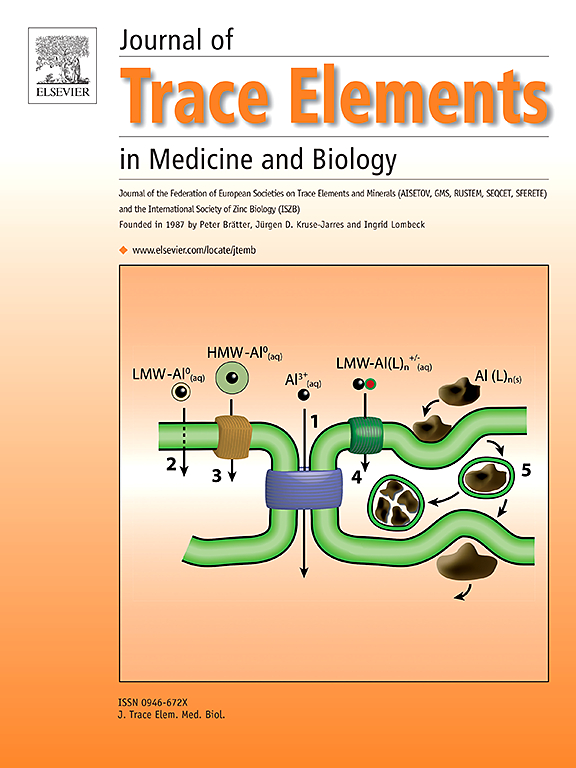Foliar application of nitrates limits lead uptake by Cucumis sativus L. plants
IF 3.6
3区 医学
Q2 BIOCHEMISTRY & MOLECULAR BIOLOGY
Journal of Trace Elements in Medicine and Biology
Pub Date : 2025-02-01
DOI:10.1016/j.jtemb.2025.127592
引用次数: 0
Abstract
Lead is a toxic heavy metal, which accumulates in the soil and is readily absorbed by plant roots. The uptake of toxic elements by crops is a serious threat to human health. For this reason, it is important to prevent the incorporation of heavy metals into the food chain. Our previous study showed that foliar application of calcium nitrate reduces the intensity of lead uptake by different plant species. A significant decrease in metal concentration was observed both in the roots and in the shoots of three crops: tomato, cucumber, and flax. The present research investigated the mechanism for limiting lead accumulation in plant tissues. The experiments were conducted on Cucumis sativus L. seedlings, grown in hydroponic conditions. To compare the role of Ca2 + and NO3- ions in the restriction of lead uptake three different calcium salts (nitrate, chloride, and formate), and two nitrates (calcium and potassium) were applied foliarly to plants. The results show that Ca(NO3)2 is more efficient in decreasing lead accumulation in tissues than other calcium salts which suggests an important role of NO3- ions in the process. In addition, the study demonstrated that the exogenous supply of nitrates helps compensate for nitrogen deficiency caused by lead action and supports the mineral balance. The reduction in lead toxicity to plants after foliar application of nitrates may be due to the stimulation of the biosynthesis of nitric oxide – a key molecule responsible for stress response.
叶面施用硝酸盐限制了黄瓜对铅的吸收。
铅是一种有毒的重金属,它在土壤中积累,很容易被植物根系吸收。农作物对有毒元素的吸收是对人类健康的严重威胁。因此,防止重金属进入食物链是很重要的。我们之前的研究表明,叶面施用硝酸钙会降低不同植物对铅的吸收强度。番茄、黄瓜和亚麻三种作物的根和茎中金属浓度均显著下降。本研究探讨了植物组织中限制铅积累的机制。以水培条件下栽培的黄瓜幼苗为试验对象。为了比较Ca2 +和NO3-离子在限制铅吸收中的作用,我们在植物叶面上施用了三种不同的钙盐(硝酸盐、氯化物和甲酸盐)和两种硝酸盐(钙和钾)。结果表明,与其他钙盐相比,Ca(NO3)2能更有效地降低组织中铅的积累,表明NO3-离子在这一过程中起着重要作用。此外,研究表明,外源硝酸盐的供应有助于补偿铅作用引起的氮缺乏,并支持矿物质平衡。叶面施用硝酸盐后对植物铅毒性的降低可能是由于刺激了一氧化氮的生物合成-一种负责应激反应的关键分子。
本文章由计算机程序翻译,如有差异,请以英文原文为准。
求助全文
约1分钟内获得全文
求助全文
来源期刊
CiteScore
6.60
自引率
2.90%
发文量
202
审稿时长
85 days
期刊介绍:
The journal provides the reader with a thorough description of theoretical and applied aspects of trace elements in medicine and biology and is devoted to the advancement of scientific knowledge about trace elements and trace element species. Trace elements play essential roles in the maintenance of physiological processes. During the last decades there has been a great deal of scientific investigation about the function and binding of trace elements. The Journal of Trace Elements in Medicine and Biology focuses on the description and dissemination of scientific results concerning the role of trace elements with respect to their mode of action in health and disease and nutritional importance. Progress in the knowledge of the biological role of trace elements depends, however, on advances in trace elements chemistry. Thus the Journal of Trace Elements in Medicine and Biology will include only those papers that base their results on proven analytical methods.
Also, we only publish those articles in which the quality assurance regarding the execution of experiments and achievement of results is guaranteed.

 求助内容:
求助内容: 应助结果提醒方式:
应助结果提醒方式:


